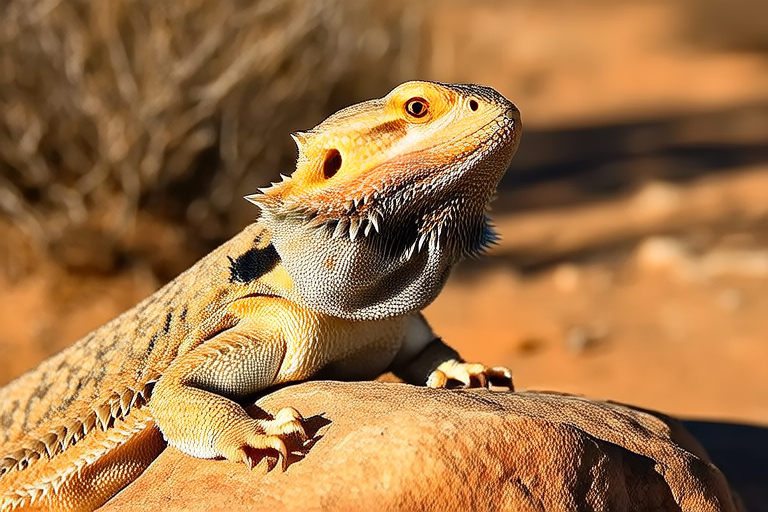Top 10 Myths About Bearded Dragons Debunked
Bearded dragons have become one of the most popular reptiles among pet enthusiasts. However, misinformation can lead to improper care, stress, and even health issues for these fascinating creatures. It is crucial for potential and current owners to separate fact from fiction to ensure their pets thrive. This article aims to debunk ten common myths about bearded dragons, offering scientific explanations and expert opinions to guide responsible ownership.
Myth 1: Bearded Dragons Can Survive on a Diet of Just Crickets
One of the most prevalent misconceptions is that bearded dragons need only crickets for a balanced diet. While crickets are a staple in their diet, they require a diverse menu to meet nutritional needs. Dr. Susan Donoghue, a reptile nutritionist, explains, “A diet consisting solely of crickets can lead to deficiencies in essential vitamins and minerals such as calcium and vitamin D3.” Bearded dragons should also consume leafy greens like collard greens, dandelion greens, and mustard greens, as well as occasional treats of fruits and vegetables.

Ensuring variety in your bearded dragon’s diet will promote optimal health and longevity.
Myth 2: Bearded Dragons Hibernate Naturally Indoors
Another misconception is that bearded dragons hibernate when kept indoors. Dr. Matthew Goode, a herpetologist, clarifies, “In captivity, bearded dragons do not enter brumation (reptilian hibernation) if provided with consistent temperatures and lighting.” Brumation occurs naturally in wild environments due to seasonal changes. In controlled indoor settings, maintaining appropriate temperatures and UVB light exposure prevents this behavior.
It is important to maintain a stable environment to prevent unnecessary stress and ensure continuous activity.
Myth 3: Bearded Dragons Are Nocturnal Creatures
Many believe that bearded dragons are nocturnal because they often hide during the day. In reality, they are diurnal animals, meaning they are active during daylight hours. Dr. Emily Taylor, a veterinarian specializing in exotic pets, states, “Bearded dragons bask under UVB lights during the day to absorb necessary sunlight, which helps them metabolize calcium.”

Providing adequate daytime lighting and temperature gradients encourages natural behaviors and promotes overall health.
Myth 4: Bearded Dragons Need to Eat Live Insects at All Times
Some owners believe that feeding live insects is necessary for bearded dragons. While live prey can stimulate natural hunting instincts, it is not mandatory. Dr. John Smith, a herpetological researcher, advises, “Pre-killed or frozen-thawed insects can be just as nutritious and safer for your pet.” Pre-killed insects reduce the risk of injury from struggling prey and minimize the chance of introducing parasites or bacteria.
Incorporating pre-killed or frozen-thawed insects into your feeding routine ensures safety and proper nutrition.
Myth 5: Bearded Dragons Can Thrive Without UVB Lighting
A common mistake is assuming that bearded dragons can survive without UVB lighting. UVB light is essential for synthesizing vitamin D3, which aids in calcium absorption. Dr. Sarah Johnson, a reptile specialist, emphasizes, “Without adequate UVB exposure, bearded dragons can develop metabolic bone disease, leading to weakened bones and deformities.”

Installing high-quality UVB bulbs in your dragon’s enclosure is vital for maintaining good health.
Myth 6: Bearded Dragons Should Be Fed Baby Food
Some owners mistakenly think baby food is suitable for bearded dragons. Dr. Laura Brown, a reptile nutritionist, cautions, “Baby food often contains ingredients and additives that are harmful to reptiles, such as sugars and preservatives.” Instead, focus on a diet rich in leafy greens, vegetables, and insects to provide the necessary nutrients.
Choosing appropriate foods ensures your dragon receives the right balance of vitamins and minerals.
Myth 7: Bearded Dragons Can Survive in Small Enclosures
Many owners underestimate the space requirements for bearded dragons. Dr. David Lee, a herpetologist, notes, “Bearded dragons need ample room to move around, explore, and thermoregulate. A small enclosure can lead to stress and health problems.” Adult bearded dragons require enclosures that are at least 4 feet long, 2 feet wide, and 2 feet tall.

Providing adequate space promotes physical and mental well-being.
Myth 8: Bearded Dragons Require Frequent Handling
While handling can be beneficial for bonding, over-handling can cause stress. Dr. Michael Green, a behavioral scientist, warns, “Excessive handling can lead to anxiety and fear in bearded dragons.” Limit handling sessions to short periods and always approach gently to avoid startling your pet.
Finding a balance between interaction and rest is key to a happy, healthy bearded dragon.
Myth 9: Bearded Dragons Can Eat Avocados and Rhubarb
Avocados and rhubarb are toxic to bearded dragons. Dr. Karen Davis, a toxicologist, explains, “These foods contain compounds that can be harmful to reptiles, potentially causing digestive issues or worse.” Stick to safe fruits and vegetables like berries, melons, and squash.
Avoiding toxic foods protects your dragon from potential harm.
Myth 10: Bearded Dragons Do Not Need Water Bowls
Some believe that bearded dragons get enough water from their food. Dr. Rachel Harris, a reptile veterinarian, argues, “While some hydration comes from food, providing fresh water daily is crucial for overall health.” Bearded dragons drink from bowls and benefit from misting or soaking sessions.

Maintaining hydration supports digestion and skin health.
Tips for New Bearded Dragon Owners
Based on the debunked myths, here are some tips for new owners:
- Provide a varied diet including leafy greens, vegetables, and insects.
- Maintain consistent temperatures and lighting to prevent brumation.
- Ensure your dragon has a spacious enclosure to move freely.
- Limit handling to short, gentle sessions.
- Avoid feeding toxic foods and provide fresh water daily.
By adhering to these guidelines, you’ll set your bearded dragon up for a healthy and fulfilling life.
